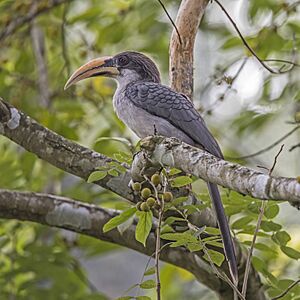Sri Lanka grey hornbill facts for kids
Quick facts for kids Sri Lanka grey hornbill |
|
|---|---|
 |
|
| at Kandy, Sri Lanka | |
| Conservation status | |
| Scientific classification | |
| Genus: |
Ocyceros
|
| Species: |
gingalensis
|
The Sri Lanka grey hornbill (scientific name: Ocyceros gingalensis) is a special bird found only in Sri Lanka. It belongs to the hornbill family, which are tropical birds living in places like Africa and Asia. This hornbill is quite common and lives in Sri Lanka all year round.
Contents
Where They Live
The Sri Lanka grey hornbill loves to live in forests. These birds are very social and often hang out together in groups. They enjoy the green, leafy areas where they can find plenty of food and safe places to build their nests.
What They Look Like
This is a fairly large bird, growing to about 45 centimetres (18 in) long. Imagine a bird almost as tall as your arm!
- Feathers: It has grey wings with black feathers at the tips, which are used for flying. Its back is also grey, but the top of its head is a brownish color.
- Tail: The tail is long and mostly black, with white parts on the sides.
- Belly: The feathers on its belly are white.
- Beak: It has a long, curved beak. Unlike some other hornbills, this one does not have a large, helmet-like growth called a casque on top of its beak.
Males and Females
Male and female Sri Lanka grey hornbills look quite similar, but there's a small difference in their beaks:
- Males: Have a cream-colored beak.
- Females: Have a black beak with a cream-colored stripe on it.
Young Birds
Baby hornbills, called immatures, look a bit different from their parents. They have dark grey feathers on their upper bodies, a cream-colored beak, and a tail with a white tip. When they fly, these birds move slowly but powerfully through the air.
How They Live and Reproduce
Sri Lanka grey hornbills usually live in pairs. Sometimes, you might see them in small groups of up to five birds. These groups often include two adult birds and two or three younger birds.
Nesting and Eggs
When it's time to have babies, the female hornbill finds a hole in a tree. She lays up to four white eggs inside. What happens next is very interesting!
- Sealing the Nest: The female blocks off the tree hole with a special "cement." This cement is made from mud, her own droppings, and fruit pulp.
- Small Opening: She leaves only a tiny opening, just big enough for the male bird to pass food through. This keeps the eggs and the mother safe from predators.
- Incubation: While the female sits on the eggs to keep them warm (this is called incubation), the male bird works hard. He brings food to the female and later to the chicks through that small opening.
What They Eat
The Sri Lanka grey hornbill is an omnivore, meaning it eats both plants and animals.


